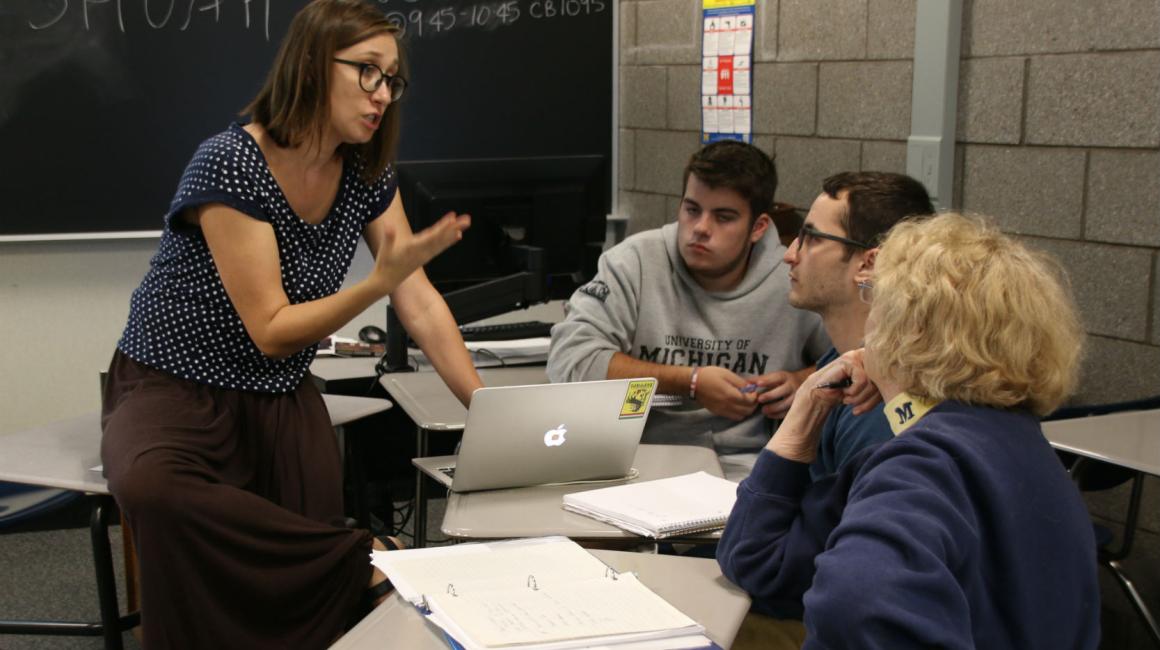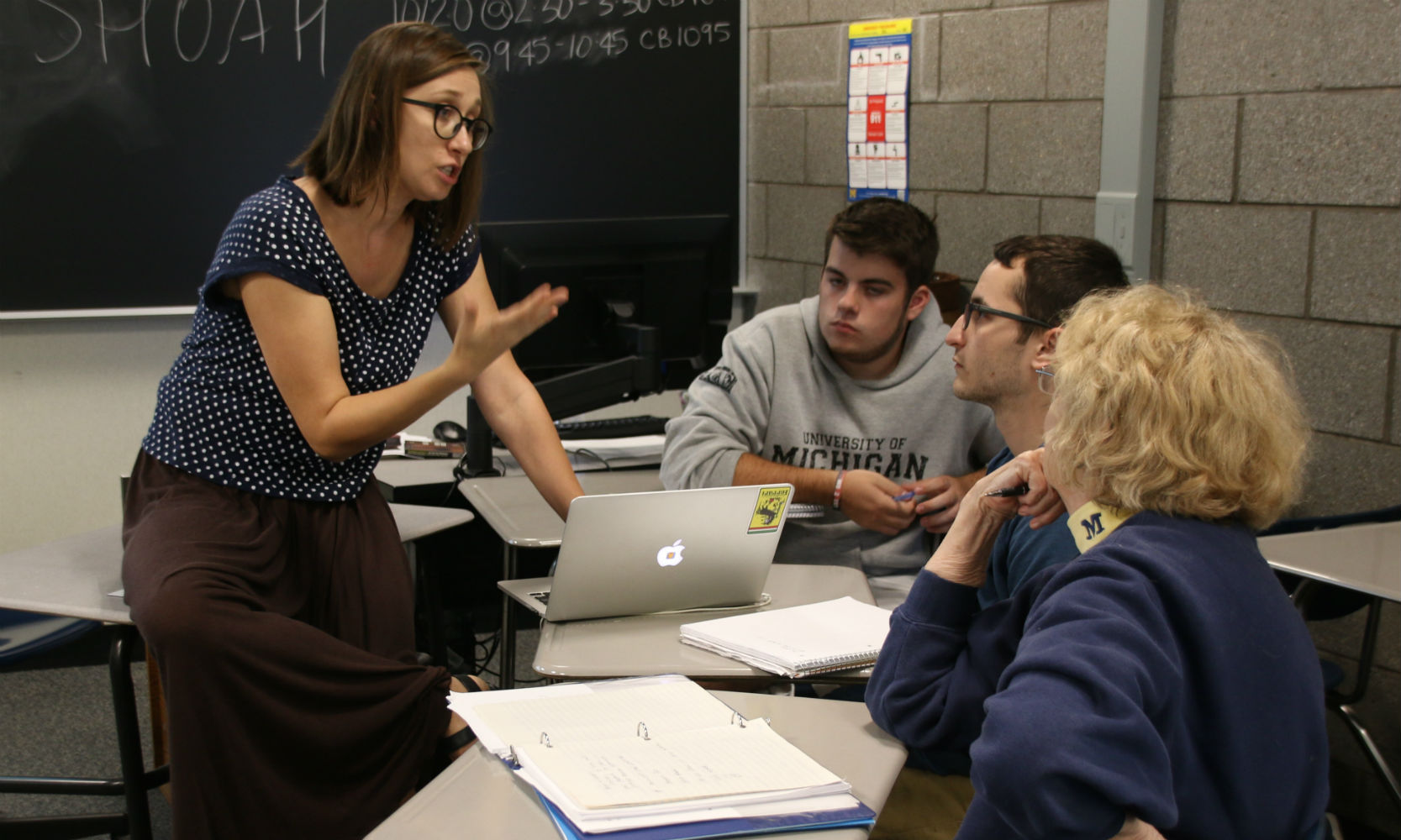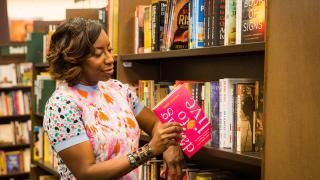
Three women push wheelbarrows.
Two women keep their heads up, foraging ahead. The third looks down, defeated.
Looking at the works in Forbidden Art: Illegal Works by Concentration Camp Prisoners in the University Gallery Space, student Peggy Stevens pauses at this particular drawing, “Women With Wheelbarrows” by Maria Hiszpanska.
“Those two women. They are not giving up,” said Stevens, who chose to focus on the piece for an assignment in her course HISTV 390: Oppression and Survival in Concentration Camps, which was designed to accompany the Forbidden Art exhibit.
The nationally touring exhibit, which came to campus through UM-Dearborn’s Voice/Vision: Holocaust Survivor Oral History Archive, was curated by the Auschwitz-Birkenau State Museum and brought to the U.S. by The Polish Mission of the Orchard Lake Schools. It illustrates both the horror of daily life in concentration camps and the hope prisoners held on to through their art.
“The two women are focused. If they get through one day, they will then think of the next day. The way to endure is to focus on the moment. I understand that focus,” said Stevens, who said she found the work relatable and inspirational after a recent breast cancer diagnosis. “You don’t want to be negative, even though you know about others who are dying. You live in the moment. You move forward.”
Anna Muller, who crafted the course, said the overarching concept of this class is to analyze how individuals cope with conditions and identities forcefully imposed on them. To Muller, that’s how she understands “forbidden art.”
“We are investigating how men and women of different races and ethnicities experienced oppression and how they use their bodies and develop skills to remain human in dehumanizing conditions,” said Muller, assistant professor of history and the Frank and Mary Padzieski Endowed Professor in Polish/Polish American/Eastern European Studies. The focus is on concentration camps, but they are also looking at censorship, racism, gender and resistance.
To share various experiences and survival strategies, Muller has included documentaries, Voice/Vision archive stories, biographies and guest speakers.
“It is important to think and reflect on what has happened in the past. There are ways, which may vary depending on your culture and your personal experiences, to compare what someone has experienced to what has happened to you. To relate to what you are hearing or seeing,” she said to the class. “This is life. This is how we tell stories. We have to make sense—as critically thinking human beings—of things happening around us.”
Guest speaker Barbara Milewski, associate professor of music and chairwoman of music and dance at Swarthmore College, came to one of the three-hour class sessions and shared the story of Krystyna Zywulska, an Auschwitz-Birkenau survivor who is known for the poems and songs she wrote while at the death camp.
“Take off your striped clothes
Kick off your clogs
Stand with me
Hold your shaved head high
The song of freedom upon our lips
Will never, never die
When winter winds blow
Through the empty barracks
Our song will linger and everyone will know”
Milewski said that Zywulska’s words gave the other inmates hope and Zywulska purpose. Her artistic expression also attracted the attention of a well-positioned older prisoner who heard the poem and was so inspired that she helped secure Zywulska’s transfer out of the death camp and into a work detail one, which saved her life.
After the presentation, Stevens said that story shows how important it is to stay positive in the face of adversity—or, if you are faltering, to find a message that is positive.
“This may have happened more than 70 years ago, but we can understand it. It’s something that transcends time,” said Stevens. “We all need inspiration.”
Reflecting on the both the classroom experience and the exhibit art, Stevens said the exhibit and the course has shown her how the human spirit can overcome incredible odds.
“Those two women pushing the wheelbarrow look like they are going to make it. Taking this class, I’m struck by all the comparisons that I’ve been able to make to my own life. These stories are about resilience. You cannot always choose your circumstances, but you can choose how they affect you.”
The Forbidden Art exhibit will be on display at the Berkowitz Gallery, located on Mardigian Library’s third floor, through Dec. 23. There is no admission charge and hours are 9 a.m. to 5 p.m. Monday through Friday.






